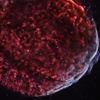Tour of SN 1006
Quicktime MPEG With closed-captions (at YouTube)
This year, astronomers around the world have been celebrating the 50th anniversary of X-ray astronomy. Few objects better illustrate the progress of the field in the past half-century than the supernova remnant known as SN 1006.
When the object we now call SN 1006 first appeared on May 1, 1006 A.D., it was far brighter than Venus and visible during the daytime for weeks. Astronomers in China, Japan, Europe, and the Arab world all documented this spectacular sight. With the advent of the Space Age in the 1960s, scientists were able to launch instruments and detectors above Earth's atmosphere to observe the Universe in wavelengths that are blocked from the ground, including X-rays. SN 1006 was one of the faintest X-ray sources detected by the first generation of X-ray satellites. A new image of SN 1006 from NASA's Chandra X-ray Observatory reveals this supernova remnant in exquisite detail. By overlapping ten different pointings of Chandra's field-of-view, astronomers have stitched together a cosmic tapestry of the debris field that was created when a white dwarf star exploded, sending its material hurtling into space. The kind of supernova is called Type Ia, and astronomers use observations of these explosions in distant galaxies as mileposts to mark the expansion of the Universe. The new Chandra data provide new details about these important objects. In many ways, SN 1006 represents just how far we have come in exploring our Universe in the past fifty years and the progress we continue to make.
[Runtime: 01:46]
Quicktime MPEG With closed-captions (at YouTube)
This year, astronomers around the world have been celebrating the 50th anniversary of X-ray astronomy. Few objects better illustrate the progress of the field in the past half-century than the supernova remnant known as SN 1006.
When the object we now call SN 1006 first appeared on May 1, 1006 A.D., it was far brighter than Venus and visible during the daytime for weeks. Astronomers in China, Japan, Europe, and the Arab world all documented this spectacular sight. With the advent of the Space Age in the 1960s, scientists were able to launch instruments and detectors above Earth's atmosphere to observe the Universe in wavelengths that are blocked from the ground, including X-rays. SN 1006 was one of the faintest X-ray sources detected by the first generation of X-ray satellites. A new image of SN 1006 from NASA's Chandra X-ray Observatory reveals this supernova remnant in exquisite detail. By overlapping ten different pointings of Chandra's field-of-view, astronomers have stitched together a cosmic tapestry of the debris field that was created when a white dwarf star exploded, sending its material hurtling into space. The kind of supernova is called Type Ia, and astronomers use observations of these explosions in distant galaxies as mileposts to mark the expansion of the Universe. The new Chandra data provide new details about these important objects. In many ways, SN 1006 represents just how far we have come in exploring our Universe in the past fifty years and the progress we continue to make.
[Runtime: 01:46]
(Credit: NASA/CXC/A. Hobart)
Return to SN 1006 (April 17, 2013)
